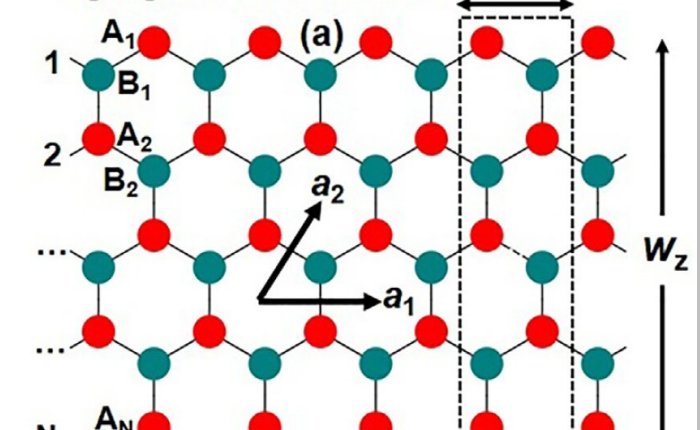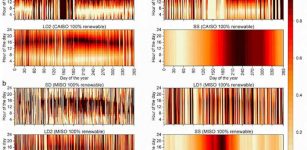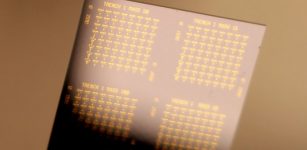A Zigzag Blueprint For Topological Electronics
Eddie Gonzales Jr. – MessageToEagle.com – A collaborative study led by the University of Wollongong confirms switching mechanism for a new, proposed generation of ultra-low energy ‘topological electronics’.
Based on novel quantum topological materials, such devices would ‘switch’ a topological insulator from non-conducting (conventional electrical insulator) to a conducting (topological insulator) state, whereby electrical current could flow along its edge states without wasted dissipation of energy.
Two-dimensional sheets of group-IV and group-V elements (2D Xenes) are topological insulators. Credit: FLEET
Such topological electronics could radically reduce the energy consumed in computing and electronics, which is estimated to consume 8% of global electricity, and doubling every decade.
Led by Dr Muhammad Nadeem at the University of Wollongong (UOW), the study also brought in expertise from FLEET Centre collaborators at UNSW and Monash University.
Resolving the Switching Challenge, and Introducing the Tqfet
Two-dimensional topological insulators are promising materials for topological quantum electronic devices where edge state transport can be controlled by a gate-induced electric field.
However, a major challenge with such electric-field-induced topological switching has been the requirement for an unrealistically large electric field to close the topological bandgap.
The cross-node and interdisciplinary FLEET research team studied the width-dependence of electronic properties to confirm that a class of material known as zigzag-Xene nanoribbons would fulfil the necessary conditions for operation, namely:
- Spin-filtered chiral edge states in zigzag-Xene nanoribbons remain gapless and protected against backward scattering
- The threshold voltage required for switching between gapless and gapped edge states reduces as the width of the material decreases, without any fundamental lower bound
- Topological switching between edge states can be achieved without the bulk (ie, interior) bandgap closing and reopening
- Quantum confined zigzag-Xene nanoribbons may prompt the progress of ultra-low energy topological computing technologies.
Zigzag Xenes Could Be Key
Graphene was the first confirmed atomically-thin material, a 2D sheet of carbon atoms (group IV) arranged in a honeycomb lattice. Now, topological and electronic properties are being investigated for similar honeycomb sheets of group-IV and group-V materials, collectively called 2D-Xenes.
2D-Xenes are topological insulators — ie, electrically insulating in their interior but conductive along their edges, where electrons are transmitted without dissipating any energy (similar to a superconductor). When a 2D-Xene sheet is cut into a narrow ribbon terminated on ‘zigzag’ edges, known as zigzag-Xene-nanoribbons, it retains the conducting edge modes characteristic of a topological insulator, which are thought to retain their ability to carry current without dissipation.
It has recently been shown that zigzag-Xene-nanoribbons have potential to make a topological transistor which can reduce switching energy by a factor of four.
The new research led by UOW found the following:
Maintaining edge states Measurements indicated that spin-filtered chiral edge states in zigzag-Xene nanoribbons remain gapless and protected against the backward scattering that causes resistance, even with finite inter-edge overlapping in ultra-narrow ribbons (Meaning that a 2D quantum spin Hall material undergoes a phase transition to a 1D topological metal.) This is driven by the edge states intertwining with intrinsic band topology-driven energy-zero modes.
“Quantum confined zigzag-Xene-nanoribbons are a special class of topological insulating materials where the energy gap of the bulk sample increases with a decrease in width, while the edge state conduction remains robust against dissipation even if the width is reduced to a quasi-one-dimension,” says FLEET researcher and collaborator on the new study A/Prof Dmitrie Culcer (UNSW). “This feature of confined zigzag-Xene-nanoribbons is in stark contrast to other 2D topological insulating materials in which confinement effects also induce an energy gap in the edge states.”
Low threshold voltage
Due to width- and momentum-dependent tunability of gate-induced inter-edge coupling, the threshold-voltage required for switching between gapless and gapped edge states reduces as the width of the material decreases, without any fundamental lower limit.
“An ultra-narrow zigzag-Xene-nanoribbon can ‘toggle’ between a quasi-one-dimensional topological metal with conducting gapless edge states and an ordinary insulator with gapped edge states with a little tweaking of a voltage knob, says lead author Dr Muhammad Nadeem (UOW). “The desired tweaking of a voltage knob decreases with decrease in width of zigzag-Xene-nanoribbons, and lower operating voltage means the device can use less energy. The reduction in voltage knob tweaking comes about due to a relativistic quantum effect called spin-orbit coupling and is highly contrasting from pristine zigzag-Xene-nanoribbons which are ordinary insulators and in which desired voltage knob tweaking increases with decrease in width.”
Topological switching without bulk bandgap closing
When the width of zigzag-Xene nanoribbons is smaller than a critical limit, topological switching between edge states can be attained without bulk bandgap closing and reopening. This is primarily due to the quantum confinement effect on the bulk band spectrum, which increases the nontrivial bulk bandgap with decrease in width.
“This behaviour is new and distinct from 2D topological insulators, where bandgap closing and re-opening is always required to change the topological state” says Prof Michael Fuhrer (Monash). “Wide zigzag-Xene-nanoribbons act more like the 2D case, where gate electric field switches edge state conductance while simultaneously closing and reopening bulk bandgap.”
“In the presence of spin-orbit coupling, topological switching mechanism in large-gap confined zigzag-Xene-nanoribbons overturns the general wisdom of utilizing narrow gap and wide channel materials for reducing threshold-voltage in a standard field effect transistor analysis,” says Prof Xiaolin Wang (UOW).
“In addition, topological quantum field effect transistor utilizing zigzag-Xene-nanoribbons as a channel material has several advantages of engineering intricacies involved in design and fabrication,” says Prof Alex Hamilton (UNSW).
Unlike MOSFET technology, in which size dependence of threshold-voltage is tangled with isolation techniques, the reduction of threshold-voltage in a topological quantum field effect transistor is an intrinsic property of zigzag-Xene-nanoribbons associated with topological and quantum mechanical functionalities.
Along with vastly different conduction and switching mechanisms, the technological aspects required for fabricating a topological quantum field effect transistor with zigzag-Xene-nanoribbons also radically differ from those of MOSFETs: There is no fundamental requirement of specialized technological/isolation techniques for a low-voltage TQFET with an energy-efficient switching mechanism.
With preserved ON-state topological robustness and minimal threshold voltage, channel width can be reduced to a quasi-one-dimension. This allows optimized geometry for a topological quantum field effect transistor with enhanced signal-to-noise ratio via multiple edge state channels.
Written by Eddie Gonzales Jr. – MessageToEagle.com Staff











